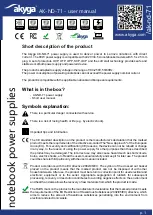
Page 51
EA Elektro-Automatik GmbH
Helmholtzstr. 31-37 • 41747 Viersen
Germany
Fon: +49 2162 / 3785-0
Fax: +49 2162 / 16230
www.elektroautomatik.de
EL 9000 B 15U/24U Series
3.5.4
Remote control via the analog interface (AI)
3.5.4.1
General
The built-in, galvanically isolated, 15-pole analog interface (short: AI) is on the rear side of the device offers the
following possibilities:
•
Remote control of current, voltage, power and resistance
•
Remote status monitoring (CV, DC input on/off)
•
Remote alarm monitoring (OT, PF, OVP, OCP, OPP)
•
Remote monitoring of actual values
•
Remote on/off switching of the DC input
Setting the
three
set values of voltage, current and power via the analog interface always takes place concurrently.
It means, that for example the voltage can’t be given via the AI and current and power set by the rotary knobs, or
vice versa. The internal resistance set value can additionally be adjusted, if resistance mode is activated via pin
R-ACTIVE.
The OVP set value and other supervision (events) and alarm thresholds can’t be set via the AI and therefore must
be adapted to the given situation before the AI will be in control. Analog set values can be supplied by an external
voltage or generated from the reference voltage on pin 3. As soon as remote control via the analog interface is
activated, the displayed set values will be those provided by the interface.
The AI can be operated in the common voltage ranges 0...5 V and 0...10 V, both representing 0...100% of the nom-
inal value. The selection of the voltage range can be done in the device setup. See section
for details. The reference voltage sent out from pin 3 (VREF) will be adapted accordingly:
0-5 V
: Reference voltage = 5 V, 0...5 V set value signal for VSEL, CSEL, PSEL and RSEL correspond to 0...100%
nominal value, 0...100% actual values correspond to 0...5 V at the actual value outputs CMON and VMON.
0-10 V
: Reference voltage = 10 V, 0...10 V set value signal for VSEL, CSEL, PSEL and RSEL correspond to 0...100%
nominal values, 0...100% actual values correspond to 0...10 V at the actual value outputs CMON and VMON.
All set values are always additionally limited to the corresponding adjustment limits (U-max, I-max etc.), which
would clip setting excess values for the DC input. Also see section
.
Before you begin, please read these important notes about the use of the interface:
After powering the device and during the start phase the AI signals undefined statuses on the
output pins such as ALARMS 1. Those must be ignored until is ready to work.
•
Analog remote control of the device must be activated by switching pin REMOTE first. Only exception is pin
REM-SB, which can be used independently
•
Before the hardware is connected that will control the analog interface, it shall be checked that it can’t provide
voltage to the pins higher than specified
•
Set value inputs, such as VSEL, CSEL, PSEL and RSEL (if R mode is activated), must not be left unconnected
(i.e. floating) during analog remote control. In case any of the set values isn’t used for adjustment, it can be tied
to a defined level or connected to pin VREF (solder bridge or different), so it gives 100%
3.5.4.2
Resolution
The analog interface is internally sampled and processed by a digital microcontroller. This causes a limited resolu-
tion of analog steps. The resolution is the same for set values (VSEL etc.) and actual values (VMON/CMON) and
is 26214 when working with the 10 V range. In the 5 V range this resolution halves. Due to tolerances, the truly
achievable resolution can be slightly lower.
3.5.4.3
Acknowledging device alarms
In case of a device alarm occurring during remote control via analog interface, the DC input will be switched off the
same way as in manual control. The device would indicate an alarm (see
) in the front display and, if activated,
acoustically and also signal most of them on the analog interface. Which alarms actually are signaled can be set
up in the device configuration menu (see
).
Some device alarms (OVP, OCP and OPP) have to be acknowledged. Also see
Acknowledgment is done
with pin REM-SB switching the DC input off and on again, means a HIGH-LOW-HIGH edge (min. 50ms for LOW),
when using the default level setting for this pin.
















































